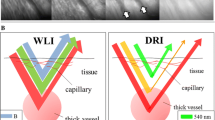Abstract
Objective
The present study aimed to investigate the accuracy of endoscopic ultrasonography (EUS) combined with Indian ink in locating target vessels of gastric varices (GVs) compared with conventional endoscopic techniques. Additionally, the characteristics of GVs under conventional endoscopy were also explored.
Methods
All 50 cirrhotic patients with GVs between August 2021 and December 2022 were included in the study. Firstly, conventional endoscopy was employed to identify GVs and to record the expected injection sites. Subsequently, EUS was used to locate the perforated vessel and the injection site was them marked with India ink followed by injection with cyanoacrylate (CYA). Finally, conventional endoscopy was used to examine GVs, to identify the marker points of Indian ink and to compare whether the injection points under conventional endoscopy were consistent with those marked with Indian ink. Furthermore, patients with consistent and inconsistent distribution of endoscopic markers and injection sites were divided into two groups.
Results
EUS could detect the perforating vessels in real time and intuitively. The distribution of markers using EUS was significantly different compared with the injection points obtained by conventional endoscopy (P < 0.001). Therefore, 20 cases were allocated to the consistent group and 30 cases to the non-consistent group. 16 patients who showed red wale signs were obtained in the consistent group and 11 patients in the non-consistent group (P = 0.048). The diameter of the largest GVs was 13.5 (10–15) mm in the consistent group compared with 10 (7.5–10) mm in the non-consistent group (P = 0.006).
Conclusion
EUS could provide the exact location of GVs, thus more accurately describing the endoscopic characteristics of the GVs. Furthermore, the red wale signs and diameter of the largest GVs obtained using conventional endoscopy were helpful in determining the location of target GVs.



Similar content being viewed by others
References
Luo X, Hernández-Gea V (2022) Update on the management of gastric varices. Liver Int 42(6):1250–1258
De Franchis R, Bosch J, Garcia-Tsao G, Faculty BV (2022) Baveno VII - Renewing consensus in portal hypertension. J Hepatol 76(4):959–974
Levy I, Binmoeller KF (2018) EUS-guided vascular interventions. Endosc Ultrasound 7(4):228–235
Nett A, Binmoeller KF (2019) Endoscopic management of portal hypertension–related bleeding. Gastrointest Endosc Clin N Am 29(2):321–337
Iwase H, Suga S, Morise K (1995) Color Doppler endoscopic ultrasonography for the evaluation of gastric varices and endoscopic obliteration with cyanoacrylate glue. Gastrointest Endosc 41(2):150–154
Thiruvengadam SS, Sedarat A (2021) The role of endoscopic ultrasound (EUS) in the management of gastric varices. Curr Gastroenterol Rep 23(1):1
Lesmana CRA, Paramitha MS, Gani RA (2021) The role of endoscopic ultrasound for portal hypertension in liver cirrhosis. J Med Ultrason 49(3):359–370
McCarty TR, Bazarbashi AN, Hathorn KE (2020) Combination therapy versus monotherapy for EUS-guided management of gastric varices: a systematic review and meta-analysis. Endosc Ultrasound 9(1):6–15
Bick BL et al (2019) EUS-guided fine needle injection is superior to direct endoscopic injection of 2-octyl cyanoacrylate for the treatment of gastric variceal bleeding. Surg Endosc 33(6):1837–1845
Shaffer RT, Francis JM, Carrougher JG (1998) India ink tattooing in the esophagus. Gastrointest Endosc 47(3):257–260
McArthur CS, Roayaie S, Waye JD (1999) Safety of preoperation endoscopic tattoo with India ink for identification of colonic lesions. Surg Endosc 13(4):397–400
Gralnek IM, Duboc MC, Garcia-Pagan JC (2022) Endoscopic diagnosis and management of esophagogastric variceal hemorrhage: European Society of Gastrointestinal Endoscopy (ESGE) Guideline. Endoscopy 54(11):1094–1120
Weilert F, Binmoeller KF (2014) Endoscopic management of gastric variceal bleeding. Gastroenterol Clin 43(4):807–818
Mohan BP et al (2020) Efficacy and safety of endoscopic ultrasound-guided therapy versus direct endoscopic glue injection therapy for gastric varices: systematic review and meta-analysis. Endoscopy 52(4):259–267
Baig M, Ramchandani M, Puli SR (2022) Safety and efficacy of endoscopic ultrasound-guided combination therapy for treatment of gastric varices: a systematic review and meta-analysis. Clin J Gastroenterol 15(2):310–319
Chetcuti Zammit S, Sanders DS, Sidhu R (2020) What is the role of submucosal tattoos in device assisted enteroscopy? Tech Coloproctol 24(5):495–496
Yang M, Pepe D, Schlachta CM (2017) Endoscopic tattoo: the importance and need for standardised guidelines and protocol. J R Soc Med 110(7):287–291
Boustière C et al (1993) Endoscopic ultrasonography classification of gastric varices in patients with cirrhosis: comparison with endoscopic findings. J Hepatol 19(2):268
Ma L et al (2019) Risk stratification for secondary prophylaxis of gastric varices due to portal hypertension. Dig Liver Dis 51(12):1678–1684
Acknowledgements
Supported by The sixth batch of health and appropriate technology promotion projects in Anhui Province, new technology of comprehensive diagnosis and treatment of esophagogastric varices under endoscopy (SYJS202103); NSF Project, MAIT Cells induce neutrophil aging through gut microbiota, A novel mechanism for the progression of alcoholic liver disease (82270623).
Author information
Authors and Affiliations
Corresponding authors
Ethics declarations
Disclosures
Zhihong Wang, Fumin Zhang, Zhuang Zeng, Yuchuan Bai, Lihong Chen, Chen Shi, Jing Jin, Qianqian Zhang, Xuecan Mei, Derun Kong have no conflicts of interest or financial ties to disclose.
Additional information
Publisher's Note
Springer Nature remains neutral with regard to jurisdictional claims in published maps and institutional affiliations.
Rights and permissions
Springer Nature or its licensor (e.g. a society or other partner) holds exclusive rights to this article under a publishing agreement with the author(s) or other rightsholder(s); author self-archiving of the accepted manuscript version of this article is solely governed by the terms of such publishing agreement and applicable law.
About this article
Cite this article
Wang, Z., Zhang, F., Zeng, Z. et al. Application of Indian ink markers for locating gastric varices under endoscopic ultrasonography. Surg Endosc 38, 633–639 (2024). https://doi.org/10.1007/s00464-023-10532-w
Received:
Accepted:
Published:
Issue Date:
DOI: https://doi.org/10.1007/s00464-023-10532-w




